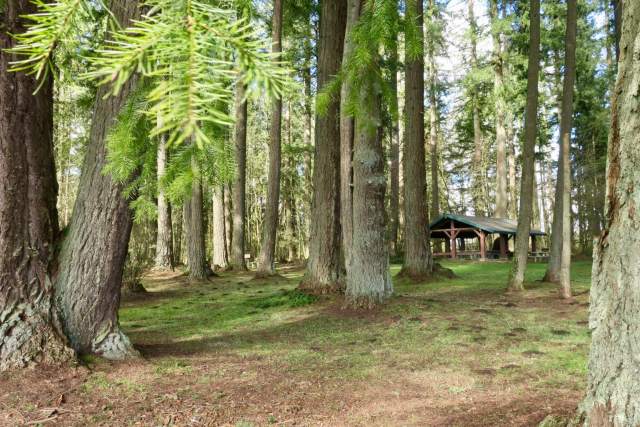Matilda N. Jackson State Park Heritage Site is probably the nicest picnic area along the Jackson Highway, yet it’s not even listed on the Washington State Parks website. Just as Matilda herself was overshadowed by her prominent husband, I suspect this state park is overshadowed by the nearby state park that’s named for him.

An all-too-familiar Oregon Trail story
Not too much is known about Matilda Nettle Glover Coontz Jackson, who is typically described as the wife of John R. Jackson and mother of their children. A Google search turned up little about her, including one article rather depressingly subtitled “Pioneer Women’s Lives Unrecorded.”
Born in 1811, Matilda came west on the Oregon Trail in 1847 with her husband, Nicholas Coontz (or Koontz; sources vary), and their four sons. Nicholas drowned trying to help an ox cross the Snake River. The tragedy apparently caused Matilda, pregnant with their fifth child, go into premature labor, and the baby died. Like many other women who ventured west only to lose their husbands along the way, a weakened and traumatized Matilda found herself in Oregon City facing an uncertain future and four young boys to raise. And like many other women in that situation, Matilda survived by choosing the best option available to her at the time: she found another husband.
Matilda’s pioneer life
She met John R. Jackson in spring 1848 and they quickly married and moved north to Jackson’s homestead. The historic cabin, where settlers decided to petition Congress for a separate Washington Territory, sits on a parcel of the original land claim and is now Jackson House State Park Heritage Site.
Matilda spent the rest of her long life (she died in 1901, aged 90) endlessly working to provide for her growing family (she and Jackson had three more children together). She was a farmer, orchardist, food preserver, candlemaker, butcher, renderer, cheesemaker, meat smoker, shearer, carder, spinner, knitter, seamstress, laundress, milkmaid, butter churner, and soap maker.
And of course, that is in addition to the work Matilda performed in support of her husband’s many occupations. The cabin where the family lived served as a courthouse, tavern, general store, post office, and hotel. We all know who cooked the meals, served them to visitors, cleaned up, made beds, cleaned the house, took care of the animals, and served as hostess.
I’m tired just reading that.
A pioneer life honored, if not exactly remembered
In many ways, Matilda’s life was typical of pioneer women of the time. Three of her seven children died before they reached adulthood. History doesn’t record the unfathomable pain she must have experienced, although one newspaper story suggests her faith helped sustain her.
I like to think that the state park site named in Matilda’s honor allows her memory to live in a tranquil place. Indeed, Matilda Jackson State Park Heritage Site, though small in size, offers an unexpected respite from busy traffic three miles west on Interstate 5 and from vehicles buzzing past on the Jackson Highway at the park’s eastern boundary.
A park for the automobile age
The park is a grove of old Douglas-firs with a picnic shelter and a short trail. During the Jackson Highway’s heyday as part of the primary north-south route between Seattle and Portland, this would have been a welcome stopping point to stretch one’s legs and let the kids burn off some energy.

A display at the entrance includes reproductions of construction plans from the 1930s, when the Civilian Conservation Corps had a camp in nearby Lewis & Clark State Park and did some work at the Matilda Jackson site. The State Parks Commission established both parks in 1922, and the much-smaller Matilda Jackson site was a gift to the state from her daughter Louisa. A 2018 grant from the Washington State Parks Foundation, a nonprofit founded in 2000 to support state parks after drastic (and ongoing) budget cuts, paid for a new entrance sign and fencing based on the 1930s CCC work.



The Oregon Trail, Matilda, and #MeToo
Just outside the entry gate, an Oregon Trail plaque placed by the Daughters of the American Revolution in 1916 is one of about a dozen markers commemorating the northern trail extensions between the Columbia River and Puget Sound. As the trail determined so much of the course of Matilda’s life, it’s fitting that this marker stands outside the park named for her.
I understand why Jackson House State Park Heritage Site gets the lion’s share of attention. It’s listed on the National Register of Historic Places because of the history made there. But I think Matilda deserves more credit, especially in this age of fourth-wave feminism and #MeToo. By dint of his gender, John got the glory. But you and I know he never would’ve been able to become the territorial celebrity he was without her unwavering support. So if you go to the Jackson House (you should, it’s only a half-mile south), be sure to stop at Matilda’s park too. Wander among the stately trees and give thanks for the strong women in your life.

Fast facts about Matilda N. Jackson State Park
- 5-acre, day-use park, open year-round
- $10 daily parking pass (buy the annual Discover Pass, a bargain at $30)
- picnic shelter
- short hiking trail
- old-growth trees

Where is the “heart” button? Thank you, Matilda.